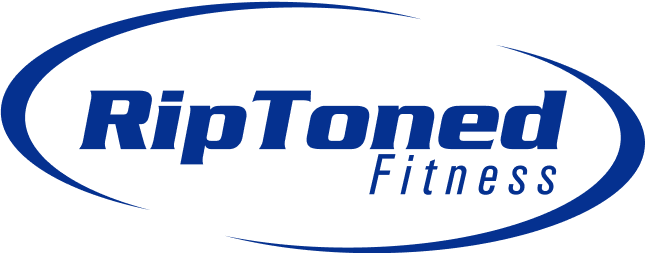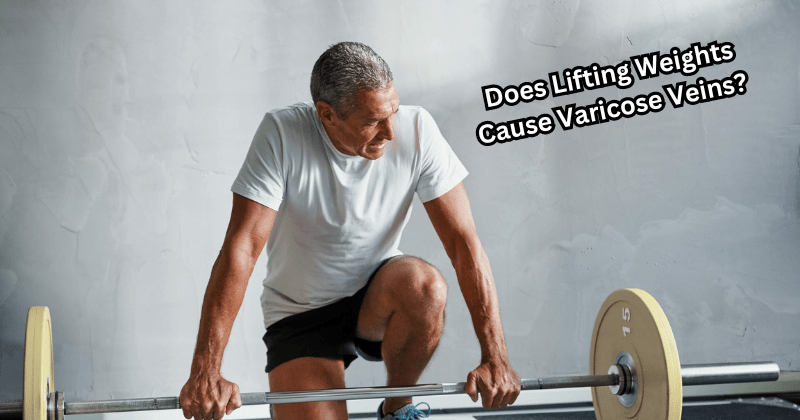Does lifting weights cause varicose veins? If you’ve noticed bulging veins or are concerned about vein health, you might be wondering if your exercise routine is to blame.
In this article, we’ll explore the link between weightlifting and varicose veins, explain the risks, and offer tips to protect your veins while staying fit.
Key Takeaways
- Weightlifting can improve blood circulation and cardiovascular health, but lifting heavy weights can stress the venous system and potentially lead to varicose veins, especially in those predisposed to vein issues.
- Adopting safe weightlifting practices, such as using lighter weights with more repetitions, warming up properly, and practicing correct breathing techniques, can help prevent varicose veins.
- Including low-impact exercises like walking, biking, swimming, and yoga, as well as wearing compression stockings and elevating legs post-workout, can support vein health and reduce the risk of varicose veins.
Understanding Varicose Veins
Varicose veins are those enlarged, twisted veins that often appear on the legs, making them a common concern for many. They occur when the one-way valves in the veins weaken or get damaged, causing blood to pool and the veins to enlarge. This condition can lead to uncomfortable symptoms such as heaviness, aching, and visible changes in skin color. In some cases, varicose veins may also present as bulging veins, adding to the aesthetic concerns.
There are several risk factors that can cause varicose veins and contribute to their development. These factors include:
- Genetics: If your parents had varicose veins, you’re more likely to develop them.
- Age: Older age is a risk factor for varicose veins.
- Obesity: Being overweight puts extra pressure on your veins.
- Pregnancy: Hormonal changes and increased blood volume during pregnancy can lead to varicose veins.
- Prolonged periods of inactivity or leg injuries: Sitting or standing for long periods can increase the risk of varicose veins.
- Smoking: Smoking can exacerbate vein problems.
Being aware of these risk factors provides a proactive approach towards vein health. Identifying the symptoms and understanding the causes empowers you to take preventive measures against varicose veins or manage them effectively should they develop. This basic understanding paves the way for an exploration of the effect of weightlifting on vein health and strategies to mitigate potential risks.
The Impact of Weightlifting on Vein Health
Weightlifting, often touted for its numerous health benefits, can improve your body’s blood circulation and promote arterial health. By encouraging the growth of new blood vessels and enhancing overall circulation, weightlifting plays a vital role in maintaining a healthy cardiovascular system.
However, there’s a flip side. Lifting heavy weights can put significant stress on the venous system, particularly if you’re predisposed to vein issues. The increased demand on your muscles and veins can weaken the valves that keep blood flowing properly, potentially leading to varicose veins. This is especially true for exercises that involve heavy weights and put excessive strain on the lower leg veins.
Some exercises to be cautious of include:
- Squats
- Deadlifts
- Lunges
- Calf raises with heavy weights, which can strain your calf muscles
If you’re concerned about developing varicose veins, it’s important to listen to your body and modify your workouts accordingly.
It’s worth mentioning that although weightlifting itself doesn’t directly lead to varicose veins, the manner in which it’s carried out can impact vein health. Proper techniques and preventive measures can make a significant difference. Grasping the equilibrium between enjoying the benefits of weightlifting and safeguarding your veins is vital for overall health.
Risk Factors Enhanced by Weightlifting
Genetics is a significant factor in the development of varicose veins. If you have a family history of venous disease, you’re at a higher risk. This genetic predisposition can be exacerbated by certain lifestyle choices, including prolonged standing or sitting and, notably, weightlifting.
Prolonged lifting of very heavy weights can put enough pressure on muscles and veins to cause valve damage. This strain can increase blood pressure inside the veins, leading to bulging and the development of varicose veins. Being aware of these enhanced risk factors can help you make informed decisions about your weightlifting routines to mitigate these risks.
Safe Weightlifting Practices to Prevent Varicose Veins
To capitalize on the benefits of weightlifting without endangering your vein health, it’s necessary to adopt safe practices. Here are some key strategies to prevent varicose veins while weightlifting:
- Warm up properly before starting your weightlifting session.
- Use lighter weights with more repetitions instead of heavy weights.
- Exhale during lifts to reduce strain on your veins and maintain healthy blood flow.
By following these practices, you can enjoy the benefits of weightlifting while keeping your veins healthy.
Proper warm-up routines prepare your muscles and vascular system for the workout, reducing the risk of injury and unnecessary strain. Opting for lighter weights with more repetitions can minimize the stress on your venous walls. Additionally, ensuring you breathe correctly during lifts helps manage blood pressure and protect your leg veins. Let’s explore each of these practices in more detail.
Warm-Up Properly
Warming up prior to exercising is vital. It gradually raises your body temperature and increases blood flow to your muscles, preparing your cardiovascular system for the workout. This not only improves muscle tone but also alleviates symptoms of varicose veins by promoting better circulation.
An adequate warm-up can ward off muscle injury, muscle fatigue, and undue strain on the vascular system. Integrating light cardiovascular exercise into your warm-up routine guarantees that your muscles and veins are primed for the demands of weightlifting. This easy action can greatly contribute to the sustenance of vein health.
Lift Lighter Weights with More Reps
Lifting lighter weights with more repetitions is a less risky approach to weight lifting, as opposed to lifting weights with heavier loads. This method helps maintain proper blood circulation and prevents excessive blood pooling, which can strain the venous walls. Diminishing the load on your veins helps you steer clear of worsening any present vein problems.
Infusing this practice into your weight training regimen can assist you in accomplishing your fitness objectives without imposing unnecessary stress on your veins. It’s a balanced approach that supports both muscle development and vein health, ensuring you stay strong and healthy.
Exhale During Lifts
Correct breathing techniques while weightlifting are crucial for regulating blood pressure and safeguarding your veins. Exhaling during the exertion phase of a lift and inhaling during the relaxation phase can help maintain healthy blood pressure levels.
Exhaling when lifting the weight and inhaling when lowering it lessens the strain on your veins and encourages improved blood flow. This straightforward but effective method can have a substantial impact on preventing varicose veins and preserving overall vein health.
Alternative Exercises for Vein Health
If weightlifting poses too many risks for your vein health, consider incorporating alternative exercises into your routine. Some low-impact activities that can improve circulation and support vein health without putting excessive strain on your veins include:
- Walking
- Biking
- Swimming
- Yoga
Walking is a fantastic low-impact activity that enhances circulation and strengthens muscles, supporting overall vein health. Other excellent choices for maintaining healthy veins include:
- Biking
- Swimming
- Yoga
- Pilates
These activities place less strain on the veins while providing a full-body workout and focusing on strength, flexibility, and the body’s blood circulation.
Incorporating these exercises into your workout routine can help prevent varicose veins and improve your overall fitness. They offer a balanced approach to staying active and healthy while minimizing the risk to your veins:
- Walking or jogging
- Cycling
- Swimming
- Yoga or Pilates
- Strength training
Additional Tips for Maintaining Healthy Veins
Beyond exercise, several lifestyle choices can contribute to maintaining healthy veins. Keeping hydrated is paramount as it aids in thinning the blood, thus facilitating freer flow and promoting improved blood circulation. Maintaining a healthy weight can also reduce pressure on your veins and improve circulation.
Eating a balanced diet rich in fiber, vitamins C and K, and rutin can improve vein health by maintaining vein wall integrity and promoting circulation. Additionally, shoes with added cushioning can help absorb shock and reduce the impact on your veins during exercise.
Wear Compression Stockings
Compression stockings are a valuable tool in promoting vein health. They:
- Apply pressure to the legs, aiding in blood flow back to the heart
- Reduce the risk of circulation problems
- Relieve symptoms such as pain and swelling
- Mitigate the severity of varicose veins.
There are various types of compression stockings available, with different levels of pressure to suit your needs. Consulting with a vein specialist can help you choose the right type for your condition and ensure you get the maximum benefit from them.
Elevate Legs Post-Workout
Raising your legs post-workout is a straightforward and efficient method to foster vein health. By raising your legs above the level of your heart, you can help gravity assist in blood flow back towards the heart, reducing blood pooling in the legs.
This practice helps reduce swelling, alleviate discomfort, and prevent blood from pooling in the lower extremities. It’s a great way to enhance recovery and support healthy veins after a strenuous workout.
When to Seek Help from a Vein Specialist
Sometimes, despite your best efforts, you might still experience symptoms of vein disease. Persistent leg pain, swelling, or noticeable raised and discolored veins under the skin are signs that you should consult a vein specialist.
Feeling heavy or weak legs at the end of the day, dry, itchy spots near the feet or ankles, or sores that do not heal are also indicators of potential vein problems. If any of these symptoms manifest, it’s imperative to seek professional advice to avert further complications.
A vein specialist is able to provide a variety of treatments for managing and treating varicose veins, including:
- Radiofrequency ablation
- Venaseal
- Varithena
- Phlebectomy
- Sclerotherapy
Prompt intervention can drastically impact the effective management of vein health.
Summary
In conclusion, weightlifting and maintaining an active lifestyle are essential for overall health, but it’s crucial to adopt safe practices to protect your vein health. Understanding varicose veins, their risk factors, and how weightlifting impacts your veins can help you make informed decisions about your fitness routine.
By incorporating alternative exercises, following safe weightlifting practices, and adopting healthy lifestyle choices, you can prevent varicose veins and maintain strong, healthy veins. Stay proactive, listen to your body, and consult a vein specialist if you experience persistent symptoms. Your veins will thank you for it!
Frequently Asked Questions
Does lifting heavy weights cause varicose veins?
No, lifting heavy weights does not directly cause varicose veins. Proper techniques and preventive measures can help mitigate the risks associated with the stress on veins.
What are the best exercises for vein health?
To improve vein health, consider incorporating low-impact exercises such as walking, biking, swimming, and yoga into your routine. These activities can help improve circulation and support overall vein health.
When should I wear compression stockings?
You should wear compression stockings during the day, especially if you spend long standing or sitting, to improve blood flow and reduce the risk of varicose veins.
When should I see a vein specialist?
You should see a vein specialist if you experience persistent leg pain, swelling, or noticeable raised and discolored veins, as they can provide proper diagnosis and treatment for your symptoms.


